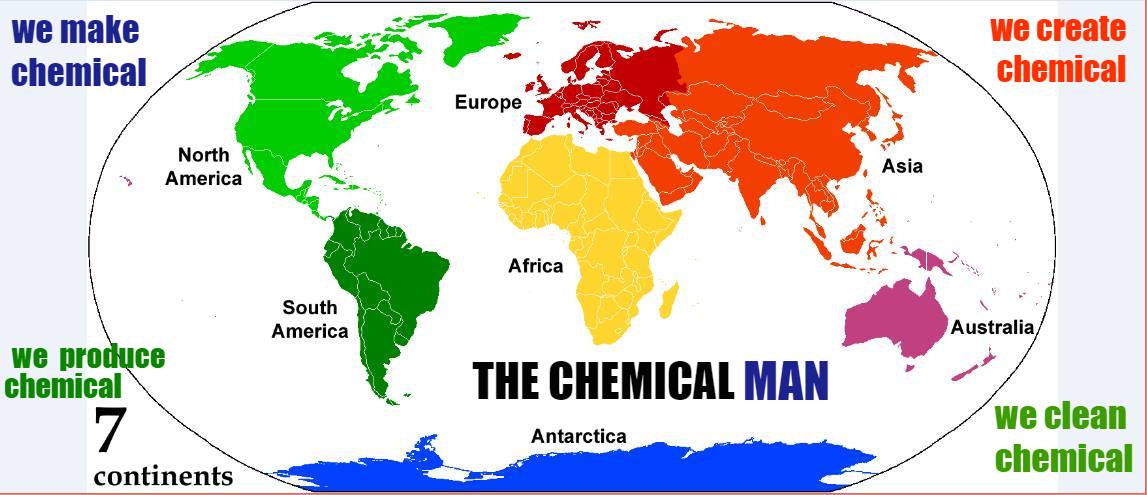Chemical Suppliers World Wide | The Chemical Man - TCM
The chemical industry comprises the companies that produce industrial chemicals. Central to the modern world economy, it converts raw materials (oil, natural gas, air, water, metals, and minerals) into more than 70,000 different products.The plastics industry contains some overlap, as most chemical companies produce plastic as well as other chemicals.
Products
"Polymers and plastics, especially polyethylene, polypropylene, polyvinyl chloride, polyethylene terephthalate, polystyrene and polycarbonate comprise about 80% of the industry’s output worldwide".These materials are often converted to fluoropolymer tubing products and used by the industry to transport highly corrosive materials.Chemicals are used in a lot of different consumer goods, but they are also used in a lot of different other sectors; including agriculture manufacturing, construction, and service industries. Major industrial customers include rubber and plastic products, textiles, apparel, petroleum refining, pulp and paper, and primary metals. Chemicals are nearly a $3 trillion global enterprise, and the EU and U.S. chemical companies are the world's largest producers.
Sales of the chemical business can be divided into a few broad categories, including basic chemicals (about 35 to 37 percent of the dollar output), life sciences (30 percent), specialty chemicals (20 to 25 percent) and consumer products (about 10 percent).
Basic Chemicals & Commodity Chemicals to Polymers and Specialty Chemicals
Basic chemicals, or "commodity chemicals" are a broad chemical category including polymers, bulk petrochemicals and intermediates, other derivatives and basic industrials, inorganic chemicals, and fertilizers. Typical growth rates for basic chemicals are about 0.5 to 0.7 times GDP. Product prices are generally less than fifty cents per pound.
Polymers, the largest revenue segment at about 33 percent of the basic chemicals dollar value, includes all categories of plastics and man-made fibers.[citation needed] The major markets for plastics are packaging, followed by home construction, containers, appliances, pipe, transportation, toys, and games.
The largest-volume polymer product, polyethylene (PE), is used mainly in packaging films and other markets such as milk bottles, containers, and pipe.Polyvinyl chloride (PVC), another large-volume product, is principally used to make piping for construction markets as well as siding and, to a much smaller extent, transportation and packaging materials.
Polypropylene (PP), similar in volume to PVC, is used in markets ranging from packaging, appliances, and containers to clothing and carpeting.
Polystyrene (PS), another large-volume plastic, is used principally for appliances and packaging as well as toys and recreation.
The leading man-made fibers include polyester, nylon, polypropylene, and acrylics, with applications including apparel, home furnishings, and other industrial and consumer use.
The principal raw materials for polymers are bulk petrochemicals.
Chemicals in the bulk petrochemicals and intermediates are primarily made from liquefied petroleum gas (LPG), natural gas, and crude oil. Their sales volume is close to 30 percent of overall basic chemicals. Typical large-volume products include ethylene, propylene, benzene, toluene, xylenes, methanol, vinyl chloride monomer (VCM), styrene, butadiene, and ethylene oxide. These basic or commodity chemicals are the starting materials used to manufacture many polymers and other more complex organic chemicals particularly those that are made for use in the specialty chemicals category .
Other derivatives and basic industrials include synthetic rubber, surfactants, dyes and pigments, turpentine, resins, carbon black, explosives, and rubber products and contribute about 20 percent of the basic chemicals' external sales.
Inorganic chemicals (about 12 percent of the revenue output) make up the oldest of the chemical categories. Products include salt, chlorine, caustic soda, soda ash, acids (such as nitric acid, phosphoric acid, and sulfuric acid), titanium dioxide, and hydrogen peroxide.
Fertilizers are the smallest category (about 6 percent) and include phosphates, ammonia, and potash chemicals.
Life sciences
Life sciences (about 30 percent of the dollar output of the chemistry business) include differentiated chemical and biological substances, pharmaceuticals, diagnostics, animal health products, vitamins, and pesticides. While much smaller in volume than other chemical sectors, their products tend to have very high prices—over ten dollars per pound—growth rates of 1.5 to 6 times GDP, and research and development spending at 15 to 25 percent of sales. Life science products are usually produced with very high specifications and are closely scrutinized by government agencies such as the Food and Drug Administration. Pesticides, also called "crop protection chemicals", are about 10 percent of this category and include herbicides, insecticides, and fungicides.
Specialty chemicals
Specialty chemicals are a category of relatively high valued, rapidly growing chemicals with diverse end product markets. Typical growth rates are one to three times GDP with prices over a dollar per pound. They are generally characterized by their innovative aspects. Products are sold for what they can do rather than for what chemicals they contain. Products include electronic chemicals, industrial gases, adhesives and sealants as well as coatings, industrial and institutional cleaning chemicals, and catalysts. In 2012, excluding fine chemicals, the $546 billion global speciality chemical market was 33% Paints, Coating and Surface Treatments, 27% Advanced Polymer, 14% Adhesives and Sealants, 13% additives and 13% pigments and inks.
Speciality chemicals are sold as effect or performance chemicals. Sometimes they are mixtures of formulations, unlike "fine chemicals," which are almost always single-molecule products.
Consumer products
Consumer products include direct product sale of chemicals such as soaps, detergents, and cosmetics. Typical growth rates are 0.8 to 1.0 times GDP.
Consumers rarely if ever come into contact with basic chemicals but polymers and speciality chemicals are the materials that they will encounter everywhere in their everyday lives, such as in plastics, cleaning materials, cosmetics, paints & coatings, electronic gadgets, automobiles and the materials used to construct their homes.These speciality products are marketed by chemical companies to the downstream manufacturing industries as pesticides, speciality polymers, electronic chemicals, surfactants, construction chemicals, Industrial Cleaners, flavours and fragrances, speciality coatings, printing inks, water-soluble polymers, food additives, paper chemicals, oil field chemicals, plastic adhesives, adhesives and sealants, cosmetic chemicals, water management chemicals, catalysts, textile chemicals. Chemical companies rarely supply these products directly to the consumer.


Leave a comment